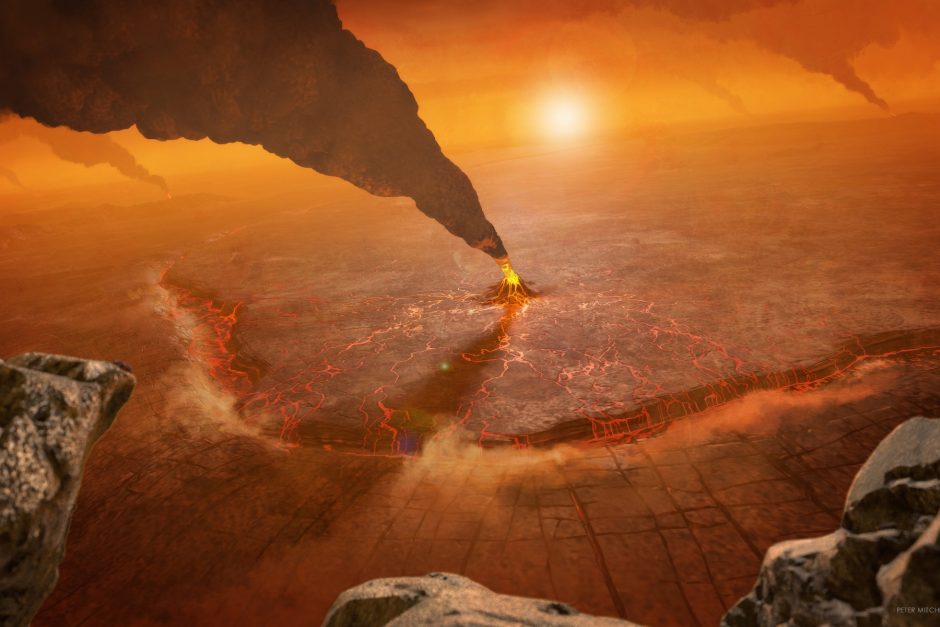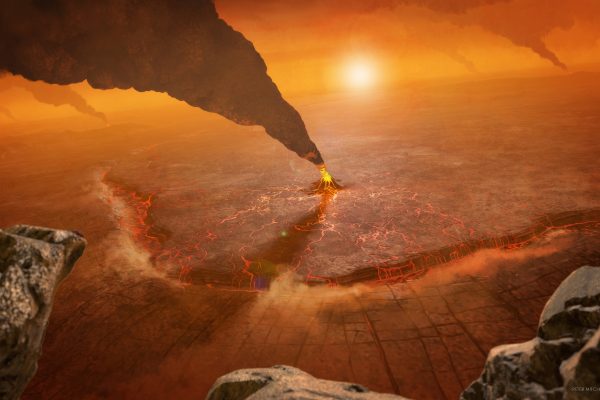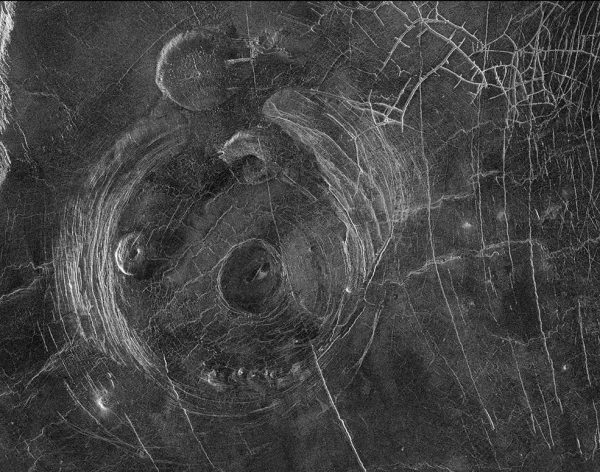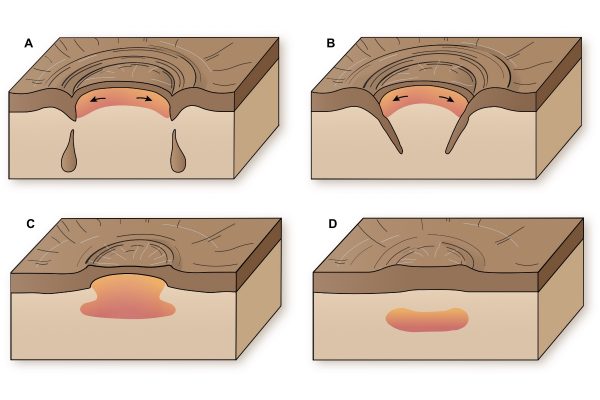Venus more tectonically alive than we thought

Several tectonic processes are occurring beneath the surface of Venus, according to a new study led by researchers from the University of Bern’s Center for Space and Habitability (CSH) and NASA. They found that many of the numerous “coronae” scattered all over Venus’ globe are associated with gravity field perturbations, hinting at the sub-surface tectonic processes. This surprising result, contradicting original assumptions about Venus’ interior being tectonically “dead”, was discovered using archive data from NASA’s Magellan mission.
Venus, our closest neighbor planet, presents many similarities to our own planet, but also major differences. Geologically, Venus distinguishes itself by a lack of global plate tectonics, which is so important in shaping the face of the Earth and renewing it.
New findings by a scientific team co-lead by Dr. Anna Gülcher from the Center for Space and Habitability (CSH) of the University and Bern and the National Centre of Competence in Research (NCCR) PlanetS, challenge the originally accepted idea that Venus has been tectonically inactive for eons. Moreover, the proposed tectonic mechanisms would explain the formation of the many “coronae” features visible on the surface of Venus. The team found most coronae are associated to regions with thinned planetary crust. They suggest bubbles of hot mantle material to rise up, swelling Venus’ crust in the coronae regions, and at many places, forcing the edge of those regions to subduct under the interior, in a similar fashion to how plate tectonic subduction works on Earth. The study has just been published in Science Advances.

This illustration of the large Quetzalpetlatl Corona located in Venus’ southern hemisphere depicts a subduction zone, where the foreground crust plunges into the planet’s interior at the rim of the corona.
© NASA/JPL-Caltech/Peter Rubin
Studying terrains unique to a planetary body
The team used data from the Magellan spacecraft from NASA, which studied Venus between 1990 and 1994. More specifically, they focused on a type of surface structure inexistant on Earth today, but common on Venus: coronae. Those structures are mostly circular or ovoid, characterized by a rim of faults and fractures creating their peculiar shape. First, the team’s co-lead re-analyzed the radar images of the surface, combined with topographic data, and found hundreds more coronae than previously identified. There are now 740 coronae identified on Venus. On average, those features have a diameter of 220km, equivalent to Switzerland from North to South. “We focused on the 75 biggest coronae, as those are the only ones with good enough gravity data resolution to study in detail,” explains Gülcher. “So, the ones we studied have sizes ranging from 350km in diameter, all the way up to 2500km in diameter – the latter of which is the equivalent to the USA from North to South or to half the surface area of Europe.”
The team then studied the position of the 75 coronae and noticed two thirds of them are associated with slight perturbations of the gravity data collected by the Magellan spacecraft. The recorded perturbations hint at the density of the lithosphere, concurring with plumes of hot, buoyant material rising up under the planetary crust. “Coronae are not found on Earth today; however, they may have existed when our planet was young and before plate tectonics had been established,” said the study’s lead author, Gael Cascioli, assistant research scientist at the University of Maryland, Baltimore County, and NASA’s Goddard Space Flight Center in Greenbelt, Maryland. “By combining gravity and topography data, this research has provided a new and important insight into the possible subsurface processes currently shaping the surface of Venus.”

This radar image from NASA’s Magellan mission shows circular fracture patterns associated with the Fotla corona, located in Venus’ southern hemisphere. The corona is about 170 kilometers across and has likely been formed by tectonic processes as explored in this study.
© NASA/JPL-Caltech
A range of Earth-like tectonic processes
The team’s computer simulations show how the large coronae likely form on Venus. “It starts with material being warmed up in the interior of Venus,” explains Anna Gülcher, “The warmed material then rises through the mantle in what we call a plume, which is located under the corona. This upwelling is what will create tectonic dynamics leading to the peculiar shape.” Closer to the surface, the warmed material becomes molten, and lifts the corona surface compared to its surrounding, and expands radially, making the corona grow in diameter. In many cases, as the plume material is pushing outwards, it collides with the surrounding crust, creating a ring of mountains on the corona edge. The thickened ring of crust may end up breaking off from below and dripping into the planet’s interior. Alternatively, just like in plate tectonics on Earth, the colder surrounding crust may end up subducting under the warmer interior, creating the characteristic faults and narrow depressions circling many coronae. There is, however, a major difference with the well-known plate tectonic processes observed on Earth: there is no global-scale network of subduction on Venus.
“The hypothesis of subduction on Venus has already been formulated by the scientific community in the nineties after the first analysis of the Magellan’s data,” points out Anna Gülcher. This theory gained new momentum in 2020, when Anna Gülcher produced the first successful three-dimensional computer simulations of such tectonic processes on Venus, successfully replicating many observed coronae. While the phenomenon was suspected for decades, the combination of topographic and gravity data with these computer simulations is perhaps the strongest evidence supporting the theory.
Still, these exact processes only explain part of the 75 coronae. Subduction is one of the four distinct processes identified by the team, which include crustal recycling at the corona rim (crustal dripping vs. subduction), while the other two processes are marked by a simple reservoir of magma affecting the crust with circular fracture patterns and volcanism.

Four tectonic scenarios explored for coronae by the scientists. The dark top layer is the planet’s lithosphere, light brown is the mantle underneath. In red/yellow the hot plume material is shown, which bulges the coronae interiors. At the surface, fracture lines are shown. The four panels indicate different tectonics: A) lithospheric dripping, B) lithospheric subduction, C) embedded plume, and D) underplated plume, all of which are proposed to be occurring on Venus today.
© Anna Gülcher
New spacecrafts soon on the way
To further explore the distinction of the various coronae, data at higher resolution will be required to resolve further the gravitational perturbations. This will be possible thanks to several probes aimed to be launched at the beginning of the 2030s: EnVision, led by the European Space Agency (ESA) and VERITAS, led by NASA. A Swiss consortium (ETHZ, KOEGL Space, FHNW, HSLU, and Space Acoustics) is involved in the first mission by contributing to the VenSpec-H instrument, which will analyze Venus’ atmospheric gasses to study volcanic activity, climate, and surface-atmosphere interactions. Most relevant to this study, both VERITAS and EnVision will measure gravity data of Venus in much higher resolution than currently available. “The higher resolution of the gravity field will enable us to carry a similar study on hundreds of smaller coronae,” concludes Anna Gülcher, who is part of the Science Team of both missions.
Publication details:
G. Cascioli, A. J. P. Gülcher, E. Mazarico, S. E. Smrekar, 2025. A spectrum of tectonic processes at coronae on Venus revealed by gravity and topography. Science Advances 11, 2025
URL: https://doi.org/10.1126/sciadv.adt5932
DOI: 10.1126/sciadv.adt5932

